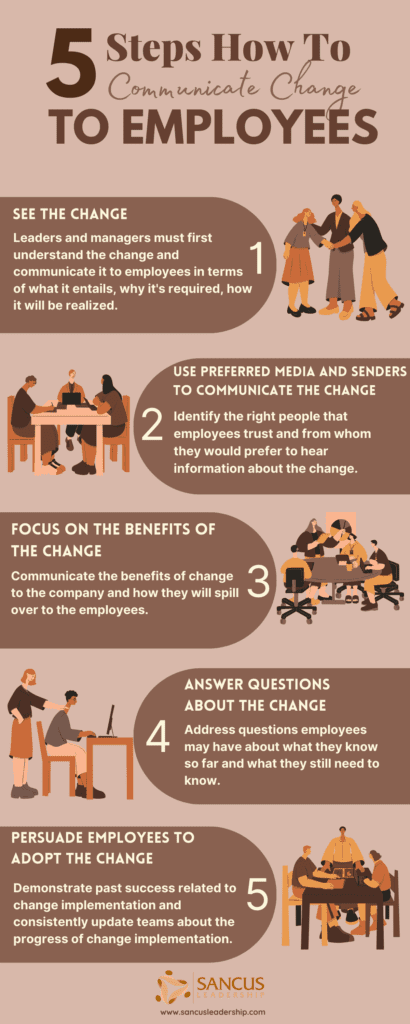At my old company, the attrition rate was high, too high. Usually, teams did one deployment and then broke up; my team stayed together for four years and did multiple deployments. This was all accomplished during a time of continuous change throughout the organization. Other teams had problems with employee retention, but we did not, and I largely attribute this to clear communication.
The steps to clear communication during change begin with the knowledge of the change among managers and leaders. Subsequently, employees are informed about the transformation’s what, how, and benefits. Use preferred channels until employees are successfully enlisted in the process.
Getting people to adopt transformation can be challenging. I put together this article to give managers and leaders at the wheel of change processes a quick reference for change communication. Let’s start with the ‘how’ of communicating change.
What is really the importance of language in small team leadership?
How Do You Communicate Through Change?

Routine and organizational culture can create a comfortable status quo that employees don’t want to be altered. For this reason, communicating through change can easily be met with resistance unless done clearly. Needless to say, poor communication can ruin a project.
Needless to say, poor communication can ruin a project.
Here’s a quick yet informative video on how to communicate effectively big changes to employees.
Managers should lead employees and stakeholders through a communication sequence to communicate through change. The sequence includes awareness, understanding, adoption, and commitment to the change.
This communication continuum lays the foundation for the steps that leading and managing teams follow in communicating change. You’ll find those steps later in the article.
When There Is Change, How Do We Communicate To Keep Performance High?

The communication continuum mentioned above outlines how clear communication brings employees aboard the change process until they become active players. It also highlights the importance of communicating effectively, with high performance in mind.
Keep performance high during change by providing psychological stability through communication. Doing this primarily means making employees know that change is leading the company to better horizons and that their jobs are secure.
Keep performance high during change by providing psychological stability through communication.
When supported psychologically, employees will keep doing their best to keep their performance high. In addition, disruptions that characterize transformation will be overcome successfully.
It’s important that you communicate how the changes will benefit the employee!
When supported psychologically, employees will keep doing their best to keep their performance high.
Steps to Effective Communication During Change

Change does not affect itself. It is the people involved in running a company that put their knowledge and skills to realize change. If leaders don’t know why change is needed and how the management intends to work with employees to realize it, the efforts for the change are already null.
Managers and leaders should adopt the following steps to ensure clear communication during change.
1. See the Change
You cannot communicate what you don’t know. For this reason, leaders and managers must first understand the change. Consequently, they can communicate it to employees and, together with them, effect it successfully.
An article by business and HR specialists, TLNT, suggests that issues related to management are the majority of the top reasons why organizational change fails. Leaders who cannot make a case for change create a clear path to failure.
Leaders who cannot make a case for change create a clear path to failure.
Managers will show they know about the change if they can communicate the following.
- What the change entails.
- Why the change is required.
- How the change will be realized.
- Who will play what role in the change process?
- Where in the company will the change happen?
- When the change will happen.
- What is the anticipated change outcome for the business and employees’ future job status?
2. Use Preferred Media and Senders To Communicate the Change
Change management involves the preparation of personnel to become change ambassadors. These change advocates communicate it to their teams and departmental colleagues.
However, employees have preferences about who should communicate the change to them. According to Rick Maurer, author of “Beyond the Wall of Resistance,” one of the three levels of change resistance is expressed in terms of “I don’t like you.”
Managers and leaders should be able to identify the right people that employees trust and from whom they would prefer to hear information about the change. Preferred change communicators could be an immediate supervisor or a team representative in the change management task force.
In addition, managers and leaders should use varied channels to communicate change. They should likewise pay attention to what works best for individual employees. In this regard, change communication mediums can include the following.
- In-person meetings and forums
- Emails and Newsletters
- Videos and PPT presentations
- Social media groups
3. Focus on the Benefits of the Change
Businesses are different from charity organizations for which people work without expecting any benefits for themselves. To fully engage in a change process, employees must be told what’s in it for them.
Managers and leaders should not just detail the benefits of change to the company. They should also communicate how the benefits will spill over to the employees.
Employee benefits from organizational change can come as follows.
- Better work resources such as innovative technology and other equipment make work easier.
- Improved employee benefits like higher remuneration and insurance packages.
- A restructured organizational culture accommodates the rapid global changes and makes employees fit better into the work context.
4. Answer Questions About the Change
At some point in the process of communicating change, employees will raise questions about what they know so far and what they still need to know.
Many questions may go back to some of the abovementioned steps, especially the “what’s in it for me” question. In this step, employees will get specific and seek to know the benefits of change for them as individuals.
For example, the leading or managing team may have explained in step 3 that employees will get salary increments from the change. At this point, employees may want to know if those in the accounting department will get the same percentage of salary increment as those in the HR department.
5. Persuade Employees To Adopt the Change
To get employees to bring their glasses together to toast change implementation, managers and leaders must persuade them that the change is worth pursuing. Persuasion will be achieved by getting all four steps above right.
However, the following additional tips can help convince your team to adopt change:
- Demonstrate past success related to change implementation so employees can see it’s doable. Where no records exist, present success cases for benchmarking.
- Clearly outline the role of each team member in effecting the change. No one will be interested in organizational transformation where they are mere spectators.
- Once you initiate the change process, consistently update teams about the progress of change implementation. Updating the teams will keep members focused on the eventual goal of the change process.
Overall, bear in mind that communication and motivation go hand in hand. You’ll need both to keep the usual company roles on track while implementing change.



